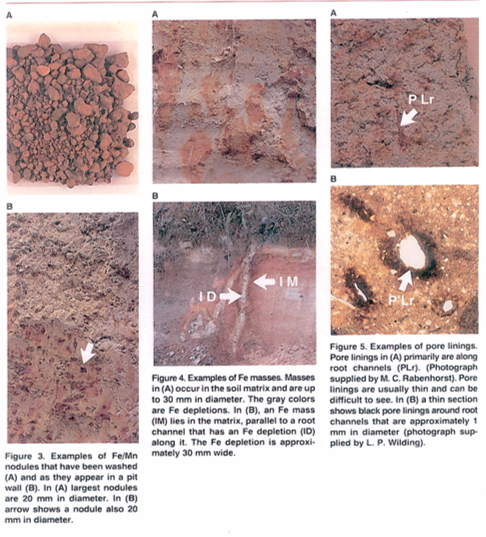
Identifying and characterizing redoximorphic features in soils and soil borings

The term redoximorphic refers to the reduction and oxidation chemical reactions and the resulting appearance or morphology of the soil horizon. While color is often used to indicate the presence of oxidized or reduced zones in soil, it is not the only indicator that can be used. This page provides information to help characterize and identify oxidation-reduction (redox) conditions in a soil. For information and a discussion on redox in soil, link here. Several links are also included at the bottom of this page. These provide information on redox chemistry in soil and how it affects soil and soil processes, including pollutants in soil.
Contents
Interpreting soil borings
- Note the soil color. Ideally the Munsell color will be provided, but if not, brown, yellow, and red colors indicated the presence of oxidized conditions (iron, manganese). Grey and blue colors indicate reducing conditions. If Munsell color is noted, high values and low chroma indicate reducing conditions.
- Does the log indicate the presence of localized redox features? Because water moves preferentially through pores in soil, pores (e.g. root channels, ped faces, insect channels) may be stained red while the soil matrix is blue or grey.
- Are there any indications the soil has been recently disturbed, introducing oxygen into a profile that was previously reduced? This may occur when a soil is tilled, for example. Introduction of oxygen into a soil will oxidize iron.
- Presence of standing water should be noted if the boring has been left in place for a sufficient time (24 hours recommended for finer-textured soils).
Characterizing redox status of soil
When logging soil descriptions while taking borings, care should be taken to provide adequate information to interpret the boring log. We recommend the following when feasible.
- Note if the soil been disturbed recently, such as being tilled or fill being introduced.
- Note the color of the soil mass (matrix). Grey or blue are associated with reducing conditions, while brown, yellow and red are associated with oxidizing conditions.
- Note the presence and abundance of stained pore lings. These can occur as coatings on a pore surface or as impregnations of the soil mass adjacent to a pore.
- Note the presence and abundance of nodules and concretions. These should have an irregular shape and typically a diffuse boundary.
- Record colors of all features using Munsell color charts.
- Accurately describe the soil water (moisture) content, using terms such as saturated, wet, moist, and dry.
- Note any other feature that might impact interpretation, such as the presence of frost.
- Color tests can be conducted, such as using a a'-Dipyridyl ( a dye used to identify the presence of reduced iron).
Potential issues with interpreting boring logs
- Grey or blue colors above brown, yellow or red colors in the soil profile. These conditions should not exist unless the upper soil has been modified in some fashion, such as presence of fill or recent changes in the soil hydric condition.
- Wet or saturated soil above soil that has a drier condition. This indicates presence of an impeding layer, such as clay, that retains water relative to the underlying layer.
- Redoximorphic features may not be present under the following conditions
- Low amounts of soluble organic carbon in the soil
- High pH (>8.0)
- Cold temperatures (inhibit biological activity which utilizes iron and manganese as electron acceptors)
- Low amounts of iron
- Oxygenated groundwater
- Presence of redoximorphic features may not reflect the current hydrologic condition
- Recently drained soils may retain presence of reduced features
- Changes in microclimate are indicated by sharp boundaries in the soil
- Contemporary features should have diffuse boundaries
Links and references
- Redoximorphic Features for Identifying Aquic Conditions. 1995. Technical Bulletin 301. North Carolina State University.
- Redoximorphic feature. 2000. Minnesota Board of Water and Soil Resources PowerPoint file.
- You Say Soil Mottles; I Say Redoximorphic Features
- Videos
- Images
- Understanding and interpreting soils and soil boring reports for infiltration BMPs
This page was last edited on 1 December 2022, at 01:21.